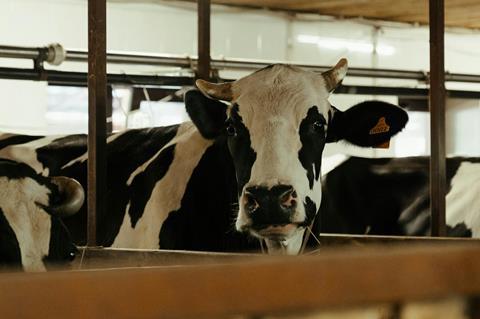A new paper from a team of Cornell University researchers shows that the highly pathogenic avian influenza H5N1 virus causes severe mastitis and decreased milk production in dairy cows, a drop-off that may extend beyond the clinical outbreak period.

Economic losses due to decreased milk production, mortality and early removal from the herd were estimated at $950 per clinically affected cow for a total cost of approximately $737,500 for just the one herd the team studied. This did not include any ongoing herd dynamics or reproductive losses for this herd.
In a paper titled “The impact of influenza A H5N1 virus infection in dairy cows” published in Nature Communications, the researchers found cows clinically infected with HPAI presented a significantly increased risk of death and of premature removal from a herd of 3,876 adult cows in Ohio.
READ MORE: New study confirms mammal-to-mammal avian flu spread
READ MORE: Antiviral-resistant variants of SARS-CoV-2 can emerge in immunocompromised people
The most remarkable finding was the long duration of diminished milk production in clinically affected cows, said co-author Diego Diel, professor of virology and director of the Virology Laboratory at the Animal Health Diagnostic Center.
Financial burden
He says pasteurization efficiently inactivates the virus, rendering the milk safe for human consumption, but that a diminution in milk production presents an enormous financial burden to the producers of affected farms, and if added up to all affected farms, it is causing major economic losses to the United States’ 9.3 million cow dairy industry.
“This represents a shock to production costs if you are affected by an outbreak,” said Matthew MacLachlan, co-author and assistant professor. “For a clinically diagnosed cow, we found an average of $950 in costs, which includes the milk you expect to lose over 60 days and the possible cost of removing them from dairy production. Even if they recover, that’s going to cost a dairy farmer $367 on average in milk losses.”
Outbreaks of avian flu in dairy herds won’t necessarily raise the price of milk for consumers, MacLachlan said.
“A lot goes into milk prices,” he said. “There’s marketing, packaging, transportation and many other factors. But an outbreak, as our study shows, causes a substantial cost to dairy producers. Although there are some government support programs for dairy farmers, they aren’t as generous as they are for poultry farmers.”
Cost to poultry industry
The HPAI outbreak, which began in 2022, has cost the U.S. poultry industry approximately $1.4 billion.
“One key strategy is implementing biosecurity measures to minimize these outbreaks, and the next step is developing vaccines,” said Felipe Peña Mosca, who was first author on the paper.
It’s a thorny problem, Diel said, because ordinarily mastitis is prevented through increased disinfection. In this particular case, those practices used for disinfection – pre-milking teat cleaning with a germicidal solution that is then toweled off – could be introducing the virus to the next cow. Study results suggest an association between cumulative exposure to the milking process and the risk of clinical disease, meaning the introduction of the virus could be during the milking process itself.
For a disease that is now widely considered endemic, rather than associated with a single outbreak, and caused by a virus that continues to evolve and spread, Diel said, its impact on the dairy industry merits more study.







No comments yet